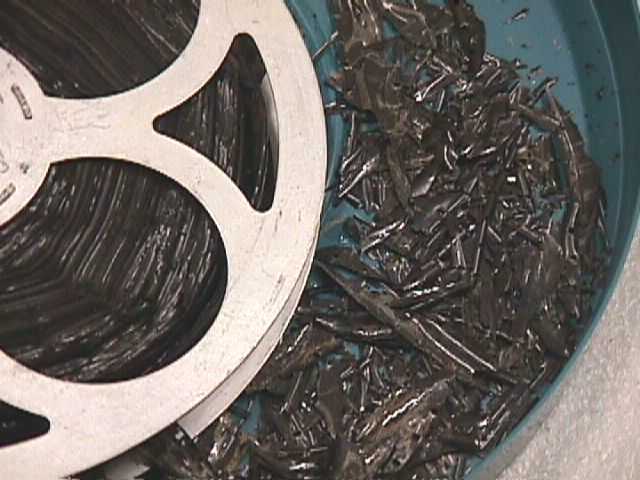
Vinegar syndrome
Vinegar syndrome is a term used to describe the chemical reaction that goes on during the deterioration of cellulose triacetate film support.
When cellulose triacetate begins to decompose, ‘deacetylation’ occurs and the acetate ion reacts with moisture to form acetic acid, producing a vinegar odour when the can is opened.
The presence of the odour does not mean the film has degraded, but rather that the reaction is taking place. However, the reaction is continuous, and once started, it cannot be stopped or reversed. In fact, the reaction is autocatalytic, which means it feeds on itself and speeds up over time. The acid produced can also react with the dyes in colour films, causing dye fading and damage to both the image as well as the base.


Molecular sieve is a new technology developed by Eastman Kodak that allegedly has the ability to retard the vinegar syndrome reaction.
Handling Vinegar Syndrome Material
A member on the American Moving Image Archivists provides the following advice:
Be aware that acetic acid is water soluble. This means that anywhere that there is moisture (eyes, nose, throat, mouth, lungs, etc.) you can form acidic solutions. Most frequently it appears as lung, throat, and sinus irritation as well as blepharatis and conjunctivitis (both irritations of the eye). In addition, there are cases of people getting mild to moderate acid burns caused by transferring these acid solutions formed on moist skin (particularly the palms of the hands) to other more sensitive areas (like the face). Acid solutions formed in the mouth can cause dental erosion too, just as sucking on lemons will do. Many places dealing with vinegar syndrome have limited resources and have to try to work safely on a limited budget. The following guidelines can be used:
- Work with small quantities at a time with as much ventilation as possible
- Work for short periods of time with frequent breaks. Depending on your situation, this may amount to 15 or 20 minutes at a time
- If you are concerned about your exposure, both Sensidyne and Dräger put out diffusion tubes (for monitoring) with clips to attach them to a pocket or lapel
- Wash frequently and shower at the end of the day
- Wear gloves. Latex or PVC will be fine. This is because many deteriorating films are also exuding plasticizers and casting aids. In particular, TPP (tri-phenyl phosphate) deteriorates via a similar mechanism to the acetate film to form first di-phenyl phosphate plus phenol, then mono-phenyl phosphate (and more phenol), and finally phosphoric acid (and phenol). Phenol may be more familiar with by its trivial name, carbolic acid.
Finally, IPI recommends cold storage as the best way to control the deterioration. Research carried out over the past six years here demonstrates that the absorption of acetic acid by anything (including buffered paper) even in sheet film sandwiched between absorbents is very limited by the diffusion rate of acetic acid out of the film. In the case of motion picture film, the situation is even worse since the film is in roll form (and acetic acid can only escape through the edges.)
This research will be presented in May 1997 at the IS&T (the Society for Imaging Science and Technology) meeting in Boston by my colleague, Jean-Louis Bigourdan.
The acetic acid can act as a catalyst (an accelerator that is not consumed) in many hydrolytic reactions (reactions with water). Sensitive materials include typical chromogenic yellow dyes, cellulose acetate and nitrate, gelatin and many other polymeric binders. In addition, acids can aid in making oxidizing agents even more active. Consider, for example (in a very simplified view) that oxygen in the air can be very corrosive in the presence of acid.
O 2 + 4H+ + 4e ->2H2O
The standard potential for this half reaction is 1.229 V which is virtually the same as for dichromate in acid (chromic acid) (standard potential of 1.232 V).
Finally, the effects of acids on paper are well known — consider the brittle books in libraries that are disintegrating. The same brittleness occurs in cardboard boxes, paper documents (movie posters) and paper based photographs.
FPC- A Kodak Company. Los Angeles AMIA-L List
The National Film and Sound Archive of Australia acknowledges Australia’s Aboriginal and Torres Strait Islander peoples as the Traditional Custodians of the land on which we work and live and gives respect to their Elders both past and present.


